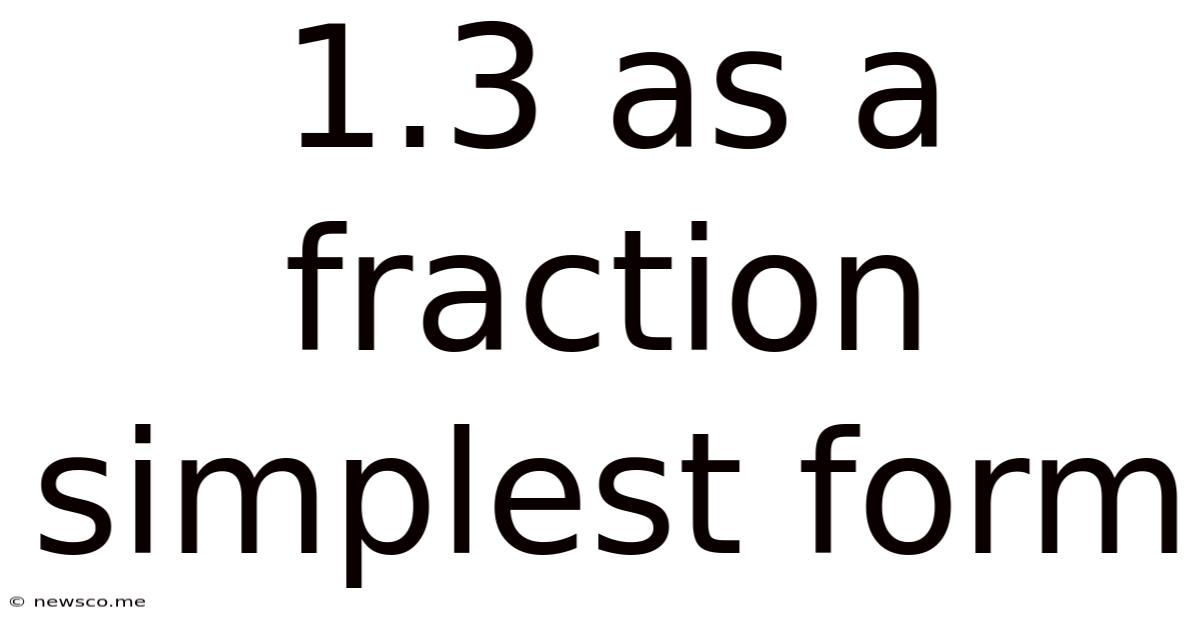1.3 As A Fraction Simplest Form
News Co
Mar 28, 2025 · 5 min read

Table of Contents
1.3 as a Fraction: A Comprehensive Guide
Understanding how to convert decimals to fractions is a fundamental skill in mathematics. This comprehensive guide will walk you through the process of converting the decimal 1.3 into its simplest fraction form, explaining the underlying concepts and providing practical examples. We'll also explore related concepts and techniques to build a solid understanding of this important mathematical operation.
Understanding Decimals and Fractions
Before diving into the conversion, let's clarify the definitions of decimals and fractions.
-
Decimals: Decimals represent numbers that are not whole numbers. They use a decimal point to separate the whole number part from the fractional part. For instance, in 1.3, '1' represents the whole number, and '.3' represents the fractional part (three-tenths).
-
Fractions: Fractions represent parts of a whole. They consist of a numerator (the top number) and a denominator (the bottom number). The numerator indicates the number of parts you have, and the denominator indicates the total number of parts the whole is divided into. For example, 1/2 represents one part out of two equal parts.
Converting 1.3 to a Fraction: Step-by-Step Guide
The conversion of 1.3 to a fraction involves several steps:
Step 1: Write the decimal as a fraction with a denominator of 1.
We begin by writing 1.3 as a fraction with a denominator of 1:
1.3/1
Step 2: Multiply the numerator and denominator by 10 for each digit after the decimal point.
Since there is one digit after the decimal point (the 3), we multiply both the numerator and the denominator by 10:
(1.3 * 10) / (1 * 10) = 13/10
Step 3: Simplify the fraction (if possible).
In this case, 13/10 is already in its simplest form. A fraction is in its simplest form when the greatest common divisor (GCD) of the numerator and the denominator is 1. The GCD of 13 and 10 is 1, meaning we cannot simplify further.
Therefore, the simplest fraction form of 1.3 is 13/10.
Understanding the Result: Mixed Numbers and Improper Fractions
The fraction 13/10 is an improper fraction, meaning the numerator (13) is larger than the denominator (10). Improper fractions can be converted into mixed numbers, which combine a whole number and a proper fraction.
To convert 13/10 into a mixed number, we perform the division:
13 ÷ 10 = 1 with a remainder of 3.
This means that 13/10 can be expressed as 1 3/10. This reads as "one and three-tenths." Both 13/10 and 1 3/10 represent the same value; the choice between them often depends on the context of the problem.
Further Examples: Converting Other Decimals to Fractions
Let's apply this method to other decimals to solidify our understanding.
Example 1: Converting 2.75 to a fraction
- Write as a fraction over 1: 2.75/1
- Multiply numerator and denominator by 100 (two digits after the decimal): (2.75 * 100) / (1 * 100) = 275/100
- Simplify the fraction: Both 275 and 100 are divisible by 25. 275/25 = 11 and 100/25 = 4. Therefore, the simplest fraction is 11/4. As a mixed number, this is 2 ¾.
Example 2: Converting 0.6 to a fraction
- Write as a fraction over 1: 0.6/1
- Multiply numerator and denominator by 10 (one digit after the decimal): (0.6 * 10) / (1 * 10) = 6/10
- Simplify the fraction: Both 6 and 10 are divisible by 2. 6/2 = 3 and 10/2 = 5. Therefore, the simplest fraction is 3/5.
Example 3: Converting 0.125 to a fraction
- Write as a fraction over 1: 0.125/1
- Multiply numerator and denominator by 1000 (three digits after the decimal): (0.125 * 1000) / (1 * 1000) = 125/1000
- Simplify the fraction: We can divide both numerator and denominator by 125. 125/125 = 1 and 1000/125 = 8. Therefore, the simplest fraction is 1/8.
Practical Applications of Decimal to Fraction Conversion
The ability to convert decimals to fractions is crucial in various fields:
- Baking and Cooking: Recipes often require precise measurements, and understanding fractions is essential for accurate conversions.
- Construction and Engineering: Precise measurements and calculations are vital, requiring a strong understanding of fractions and decimals.
- Finance: Working with percentages and interest rates often involves converting decimals to fractions for calculations.
- Science: Many scientific calculations involve fractions and decimals, requiring a strong understanding of conversions.
Advanced Concepts: Recurring Decimals
Not all decimals are as straightforward to convert as the examples above. Recurring decimals (decimals with digits that repeat infinitely) require a different approach. For example, converting 0.333... (where the 3 repeats indefinitely) to a fraction involves algebraic manipulation.
Let's represent 0.333... as 'x':
x = 0.333...
Multiplying both sides by 10:
10x = 3.333...
Subtracting the first equation from the second:
10x - x = 3.333... - 0.333...
9x = 3
x = 3/9
Simplifying this fraction, we get 1/3.
Conclusion: Mastering Decimal to Fraction Conversions
Converting decimals to fractions is a fundamental skill with widespread applications. This guide has provided a comprehensive understanding of the process, covering various examples and advanced concepts. By mastering this skill, you equip yourself with a valuable tool for various mathematical and practical applications, improving your problem-solving abilities and overall mathematical proficiency. Remember to always simplify your fractions to their lowest terms for the most accurate and concise representation. Consistent practice will solidify your understanding and build confidence in tackling more complex conversions. Now, go forth and conquer those fractions!
Latest Posts
Related Post
Thank you for visiting our website which covers about 1.3 As A Fraction Simplest Form . We hope the information provided has been useful to you. Feel free to contact us if you have any questions or need further assistance. See you next time and don't miss to bookmark.